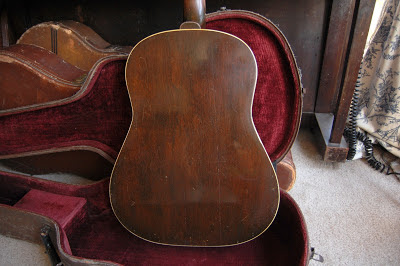I like to post pictures of guitars on Instagram and sometimes I will search hash tags for other old guitars. Today I found this one, a 1934 Gibson L-00. Neither the guitar or the pictures belong to me (unfortunately!).
This guitar, bearing the batch number 1212 - 31 was manufactured in 1934 according to Spann's Guide to Gibson: 1902-1941. It features the smaller sunburst typical of the early 30s. Supposedly the sunburst was small because wood supplies were not very good during the depression. The black part of the sunburst served to cover up imperfections in the wood.
The tuners have been changed but they look very similar to what would have been on there. I think that these are the cheaper tuners that Harmony used on their guitars in the 60s. Everything else on the guitar looks to be original. I don't see any bad repairs but I don't have any shots of the underside of the top.
This guitar, bearing the batch number 1212 - 31 was manufactured in 1934 according to Spann's Guide to Gibson: 1902-1941. It features the smaller sunburst typical of the early 30s. Supposedly the sunburst was small because wood supplies were not very good during the depression. The black part of the sunburst served to cover up imperfections in the wood.
Structurally, this guitar is very similar to my '33 L-00. One way that it differs is in the lining used to join the sides to the top and bottom of the guitar. You can see from the photo above that this guitar has the modern, kerfed lining. My guitar has the solid, steam bent lining. See below:
There was a soldier overseas during World War II that wanted to someday be a touring Country Western musician. He bought this guitar used upon his return from the war. He followed his dream for a while but soon opted for the life of a family man instead of that of a touring musician. He still played every once in a while with some other musicians. He played this guitar until his death. It was then passed on to his granddaughter where she displays it proudly on her wall.
The tuners have been changed but they look very similar to what would have been on there. I think that these are the cheaper tuners that Harmony used on their guitars in the 60s. Everything else on the guitar looks to be original. I don't see any bad repairs but I don't have any shots of the underside of the top.
What a stunning little Gibson! After I wrote this I took mine out of its case and played Mississippi John Hurt's version of "Make Me a Pallet on the Floor" and remembered why these are so popular for fingerstyle blues.
TVG











































